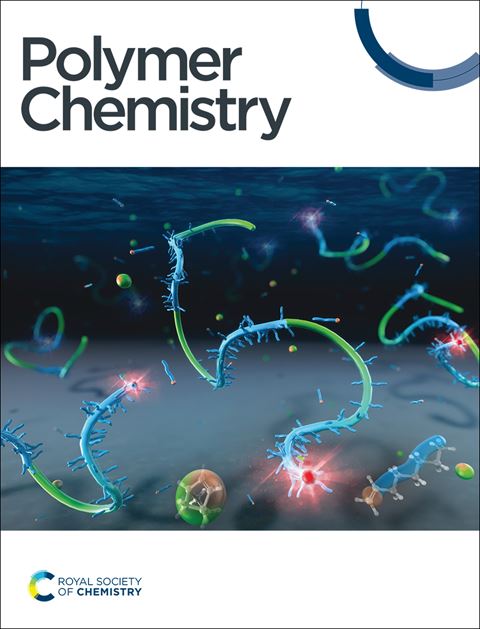结合Ugi多组分聚合和raft介导的PISA,聚赖氨酸修饰的具有可调形态的颗粒
IF 3.9
2区 化学
Q2 POLYMER SCIENCE
引用次数: 0
摘要
本文报道了Ugi多组分反应(Ugi MCR)和聚合诱导自组装(PISA)相结合制备聚(ε- l -赖氨酸)修饰的两亲性纳米粒子。首先,通过加入三硫代碳酸盐(TTC)对boc保护的l -赖氨酸进行一锅Ugi MCR,合成了一种用于可逆加成-断裂链转移(RAFT)聚合的大分子链转移剂(macroCTA)。得到的P / LL-TTC用于疏水甲基丙烯酸2-羟丙酯(HPMA)在水中的链延伸。该反应通过PISA机制进行,导致两亲性嵌段共聚物的形成,这些共聚物可以自组装成各种形态,包括球体、短蠕虫状结构和囊泡,尺寸从100纳米以下到1微米以上。这项工作展示了用多肽修饰的水分散纳米颗粒的概念验证,这在生物应用中是非常需要的(例如纳米医学中的隐形货物,生物分离,抗菌涂层等)。本文章由计算机程序翻译,如有差异,请以英文原文为准。

Poly(ε-l-lysine)-decorated particles with a tunable morphology by a combination of Ugi multicomponent polymerisation and RAFT-mediated PISA†
We report herein the unprecedented combination of the Ugi multicomponent reaction (Ugi MCR) and Polymerisation-Induced Self-Assembly (PISA) to fabricate poly(ε-l-lysine) (PεLL) decorated amphiphilic nanoparticles. First, using the one-pot Ugi MCR of Boc-protected l-lysine with the addition of a trithiocarbonate (TTC) compound, a macromolecular chain transfer agent (macroCTA) for Reversible Addition–Fragmentation chain-Transfer (RAFT) polymerisation was synthesised. The obtained PεLL-TTC was then used for chain extension of the hydrophobic 2-hydroxypropyl methacrylate (HPMA) in water. The reaction proceeded via the PISA mechanism, leading to the formation of amphiphilic block copolymers that self-assembled into a variety of morphologies—including spheres, short worm-like structures, and vesicles—spanning sizes from below 100 nm to over 1 μm. This work showcases a proof-of-concept to prepare water-dispersed nanoparticles decorated with polypeptoids, which are highly desired in biological applications (e.g. stealth-cargo in nanomedicine, bio-separation, antibacterial coating, etc.).
求助全文
通过发布文献求助,成功后即可免费获取论文全文。
去求助
来源期刊

Polymer Chemistry
POLYMER SCIENCE-
CiteScore
8.60
自引率
8.70%
发文量
535
审稿时长
1.7 months
期刊介绍:
Polymer Chemistry welcomes submissions in all areas of polymer science that have a strong focus on macromolecular chemistry. Manuscripts may cover a broad range of fields, yet no direct application focus is required.
 求助内容:
求助内容: 应助结果提醒方式:
应助结果提醒方式:


